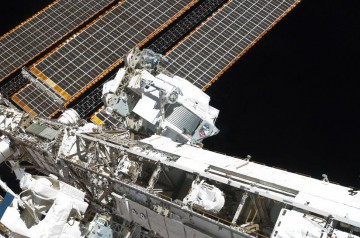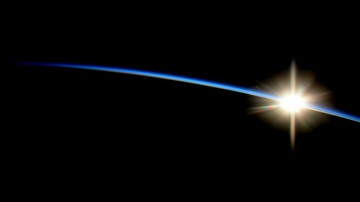
According to Vic Cooley, Lead Increment Specialist for Expedition 41/42, the crew of the International Space Station (ISS) has been as busy as ever this week, with research projects in full swing, while the crew onboard also prepares for Expedition 41 to return home to Earth next week.
Over the last week NASA astronaut Barry “Butch” Wilmore performed support work for the Alpha Magnetic Spectrometer (AMS-02) investigation, finishing a wake radiator photography survey in the Mini-Research Module 2. The study is trying to find proof of anti-matter, as well as high levels of radiation originating from distant stars that could potentially hurt future crews on their journeys to Mars—answers to questions about fundamental physics that are hard to research from Earth.

Image Credit: NASA
In addition to his work on AMS-02, Wilmore also finished checks on the new IMAX camera, which will shoot a documentary from the ISS called “A Perfect Planet,” a three-dimensional movie for all ages that will use captured images from the ISS as it orbits Earth to show how natural and human forces mold the planet. Its primary goal is to educate future generations on the importance of conservation, sustainability, and awareness of our environment.
Alexander Gerst, astronaut for the European Space Agency (ESA), was busy installing a high-speed camera, a gas filter, a gas purification cartridge, and a sample chamber into the station’s Electromagnetic Levitator (EML).
According to NASA: “The EML is a multi-user facility for the melting and solidification of conductive metals, alloys, or semiconductors, in ultra-high vacuum, or in high-purity gaseous atmospheres. For scientists observing liquid metals cooling in weightlessness, the EML removes unnecessary complexity to reveal the core processes of physics. The electromagnetic levitator takes things a step further and suspends the metals in mid-air as they melt and solidify.”
The aim of the research is to help scientists further understand an alloy’s surface tension, viscosity, melting range, fraction solid, specific heat, heat of fusion, mass density, and thermal expansion, along with other findings.

On Oct. 25, the SpaceX-4 Dragon capsule returned to Earth with the Commercial Protein Crystal Growth-High-density protein crystal growth Modified investigation (CPCG-HM) that NASA astronaut Reid Weisman completed final operations for just prior to its trip home.
The project is an extension of an ongoing study of the proteins that move signals or molecules to and from a cell’s interior or helps cells identify each other for immune responses. Sometimes the crystalline structure the proteins form in microgravity is too fragile to form under the force of the Earth’s gravity, so they are created on the ISS and sent back to Earth for X-ray analysis. These pure crystals will give us information about the protein’s structure, which will help pave the way toward a smooth, structure-based design for a larger array of medicines to treat diseases and disorders.
Along with all of the above, the human research investigations including Journals, Cardio Ox, Pro K, Biochemical Profile, Sprint, Ocular Health, Biological Rhythms, and Microbiome continued for several of the crew members.
This is the first in what will become a weekly recap series of ISS activities for our readers, with each weekly recap publishing every Sunday evening.
Want to keep up-to-date with all things space? Be sure to “Like” AmericaSpace on Facebook and follow us on Twitter: @AmericaSpace




This weekly series on ISS activities is a great idea! Looking forward to each week’s installment.
Agreed. It is both logical and important to have the public and private sector actively engaged in the many scientific experiments and research conducted on the ISS. Pipe it into schools as well? Why not?